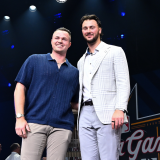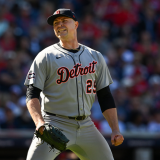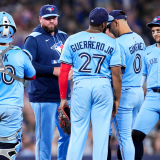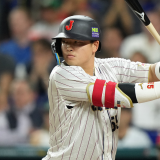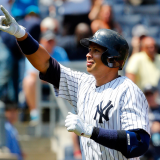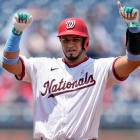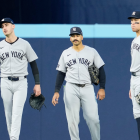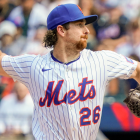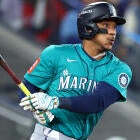James Wood debut: What other realistic steps Nationals can take to spur unlikely playoff run
Can Washington make a run without derailing its long-term aspirations?

The Washington Nationals will reportedly promote outfielder James Wood, one of the best prospects in the minor leagues, ahead of Monday's game versus the New York Mets. Wood, the key piece in the Juan Soto trade return, will be making his MLB debut in front of a home crowd.
Between now and then, the Nationals will play a three-game set against the Tampa Bay Rays, winners of seven of their last 10 games, that could shape their plans for the July 30 trade deadline. The Nationals, 38-42, will enter Friday's series opener, having lost three consecutive games. They're now three games back in the wild-card picture, a fact that may say more about the wide-open state of that race than anything specific to the Nationals.
To be certain, the Nationals do have a chance to make their first playoff appearance since winning the 2019 World Series. There are a few factors working against them, however, including a schedule that grades as one of the toughest remaining in the NL. These Nationals also, let's face it, were not built to compete this season; their winter consisted largely of general manager Mike Rizzo adding veteran rentals he could spin off at the deadline -- Jesse Winker, Nick Senzel, and the like.
Sometimes, teams, like packages, arrive earlier than expected. Whether or not these Nationals will prove to be such an example is to be seen. But Wood's promotion made us think: what could Rizzo and the Nationals do over the next month to better position them for a run without derailing their long-term aspirations? Below, we identified four realistic and attainable goals.
1. Figure out first base
A few years back, Joey Meneses was one of the best individual stories in baseball: a 30-year-old rookie who made good on his long-awaited first MLB opportunity by homering 13 times in 56 games. Meneses regressed last season to league-average production, and now, in his age-32 season, he's been putrid through the first half of this season. To wit, his .240/.297/.319 slash line results in a 75 wRC+ that makes him the worst-hitting regular first baseman in all the majors.
Meneses' advanced age and limited profile -- he's a right-right first baseman who seldom walks and isn't slugging -- makes it difficult to argue that the Nationals should give him much longer before finding a different solution at the cold corner. That could mean turning first base over to an internal candidate (we'll touch on one scenario later), or it could mean pursuing an external option -- perhaps a reunion with Josh Bell, or taking a swing on someone like Andrew Vaughn.
Whatever the preferred answer, this would seem like an easy starting point for the Nationals.
2. Upgrade the pitching staff
Here's another piece of low-hanging fruit. To be clear: we're not suggesting the Nationals would (or should) chase after Garrett Crochet, Mason Miller, or some of the other impact-caliber arms; rather, we think the Nationals could improve their staff by sticking to rental middle relievers and maybe a back-end starter -- groups that, historically, tend to come reasonably cheap.
As it stands, the Nationals rotation includes two pitchers, Patrick Corbin and DJ Herz, who have ERA+ below 75. The Nationals have two starters nearing the end of their rehab assignments in All-Star righty Josiah Gray and former first-round pick Cade Cavalli. Gray should get a spot when he's ready, though we're not sure the Nationals will rush to slot Cavalli in -- after all, he's thrown eight innings since August 2022. Either way, it probably wouldn't hurt the Nationals to survey the back-end starter rental market, if only as an insurance policy against Trevor Williams' absence.
Every contender (or pseudo-contender) wants a new reliever at the deadline. The Nationals ought to be no exception. FanGraphs houses a metric called "meltdowns" that gauges how often a bullpen is responsible for a significant loss in win probability. Basically, it's a way to place extra importance on the relievers who matter, for they're the ones pitching most frequently when the game's outcome is in doubt. The Nationals' bullpen may rank 14th in unit ERA, but they're a bottom-10 squad in the meltdowns category. Adding one or two relief arms could have a cascading effect that helps the entire bullpen do a better job of holding onto leads down the stretch.
3. Get Ruiz on track
One position that's always difficult to fill through the trade market is catcher. This summer won't prove any different in that respect. For that reason and others, it's in the Nationals' best interest to figure out what's going on with Keibert Ruiz.
Ruiz, 25, had hit .256/.310/.388 (97 OPS+) over his first full seasons with the Nationals. This year, he's batting just .200/.238/.295 (55 OPS+). Basically, everything that can trend in the wrong direction has trended in the wrong direction through the first half of the season. He's hitting the ball weaker on average; he's walking less often (not that he ever did that too much); he's striking out more often (not that he's doing that too much, either); and he's skying the ball more, resulting in an increase in pop-ups.
Ruiz's defense doesn't grade well through the lenses of advanced stats -- he ranks in the 24th percentile in framing and in the 3rd percentile in caught stealing above average — and the Nationals sorely need him to get back to hitting at a league-average clip for him to hold the kind of value they need from the catcher position.
4. Bring along internal reinforcements
Bringing up Wood is a good start on this front, but the Nationals still have a few other internal cards to play that could boost their big-league roster over the coming months.
On the positional side, the Nationals have outfielder Dylan Crews, the No. 2 pick in last summer's draft, and third baseman Brady House coming along. Crews is a recent Triple-A arrival who probably won't factor into the big-league plans until later in the year. House, conversely, has spent all season at Double-A, where he's performed well enough (109 wRC+ with 13 home runs in 69 games) that the Nationals should contemplate moving him up to Triple-A sooner than later.
The Nationals should absolutely prioritize that duo's long-term development to any short-term gains at the big-league level that come from rushing them along, but say they each have a strong few weeks at Triple-A -- at some point, the Nationals would at least have to consider pressing the button. Doing so would then enable the Nationals to add length to their lineup, likely solving their aforementioned first-base issue by enabling them to relocate a veteran there.
On the pitching side, we already mentioned above how the Nationals have some arms coming -- like Gray and Cavalli -- and how they could factor into the equation.
Would checking off these four boxes -- improving at first base and on the staff, getting Ruiz in order, and keeping an open mind with more homegrown talents -- allow the Nationals to make an unexpected playoff push? Maybe not. But Wood's arrival should at least get the Nationals dreaming big and thinking about what comes next.


